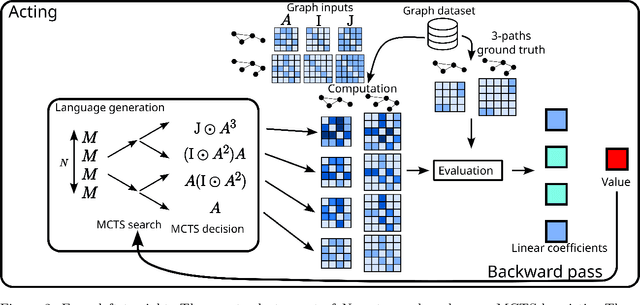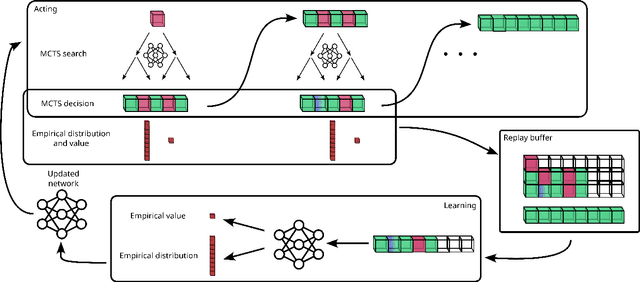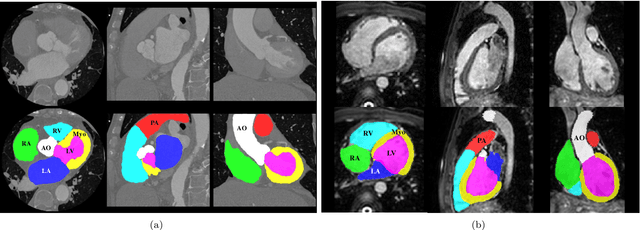Jean-Yves Ramel
Finding path and cycle counting formulae in graphs with Deep Reinforcement Learning
Oct 02, 2024



Abstract:This paper presents Grammar Reinforcement Learning (GRL), a reinforcement learning algorithm that uses Monte Carlo Tree Search (MCTS) and a transformer architecture that models a Pushdown Automaton (PDA) within a context-free grammar (CFG) framework. Taking as use case the problem of efficiently counting paths and cycles in graphs, a key challenge in network analysis, computer science, biology, and social sciences, GRL discovers new matrix-based formulas for path/cycle counting that improve computational efficiency by factors of two to six w.r.t state-of-the-art approaches. Our contributions include: (i) a framework for generating gramformers that operate within a CFG, (ii) the development of GRL for optimizing formulas within grammatical structures, and (iii) the discovery of novel formulas for graph substructure counting, leading to significant computational improvements.
Technical report: Graph Neural Networks go Grammatical
Mar 02, 2023



Abstract:This paper proposes a new GNN design strategy. This strategy relies on Context-Free Grammars (CFG) generating the matrix language MATLANG. It enables us to ensure both WL-expressive power, substructure counting abilities and spectral properties. Applying our strategy, we design Grammatical Graph Neural Network G$ ^2$N$^2$, a provably 3-WL GNN able to count at edge-level cycles of length up to 6 and able to reach band-pass filters. A large number of experiments covering these properties corroborate the presented theoretical results.
Evaluation of Algorithms for Multi-Modality Whole Heart Segmentation: An Open-Access Grand Challenge
Feb 21, 2019



Abstract:Knowledge of whole heart anatomy is a prerequisite for many clinical applications. Whole heart segmentation (WHS), which delineates substructures of the heart, can be very valuable for modeling and analysis of the anatomy and functions of the heart. However, automating this segmentation can be arduous due to the large variation of the heart shape, and different image qualities of the clinical data. To achieve this goal, a set of training data is generally needed for constructing priors or for training. In addition, it is difficult to perform comparisons between different methods, largely due to differences in the datasets and evaluation metrics used. This manuscript presents the methodologies and evaluation results for the WHS algorithms selected from the submissions to the Multi-Modality Whole Heart Segmentation (MM-WHS) challenge, in conjunction with MICCAI 2017. The challenge provides 120 three-dimensional cardiac images covering the whole heart, including 60 CT and 60 MRI volumes, all acquired in clinical environments with manual delineation. Ten algorithms for CT data and eleven algorithms for MRI data, submitted from twelve groups, have been evaluated. The results show that many of the deep learning (DL) based methods achieved high accuracy, even though the number of training datasets was limited. A number of them also reported poor results in the blinded evaluation, probably due to overfitting in their training. The conventional algorithms, mainly based on multi-atlas segmentation, demonstrated robust and stable performance, even though the accuracy is not as good as the best DL method in CT segmentation. The challenge, including the provision of the annotated training data and the blinded evaluation for submitted algorithms on the test data, continues as an ongoing benchmarking resource via its homepage (\url{www.sdspeople.fudan.edu.cn/zhuangxiahai/0/mmwhs/}).
Employing fuzzy intervals and loop-based methodology for designing structural signature: an application to symbol recognition
Apr 30, 2010



Abstract:Motivation of our work is to present a new methodology for symbol recognition. We support structural methods for representing visual associations in graphic documents. The proposed method employs a structural approach for symbol representation and a statistical classifier for recognition. We vectorize a graphic symbol, encode its topological and geometrical information by an ARG and compute a signature from this structural graph. To address the sensitivity of structural representations to deformations and degradations, we use data adapted fuzzy intervals while computing structural signature. The joint probability distribution of signatures is encoded by a Bayesian network. This network in fact serves as a mechanism for pruning irrelevant features and choosing a subset of interesting features from structural signatures, for underlying symbol set. Finally we deploy the Bayesian network in supervised learning scenario for recognizing query symbols. We have evaluated the robustness of our method against noise, on synthetically deformed and degraded images of pre-segmented 2D architectural and electronic symbols from GREC databases and have obtained encouraging recognition rates. A second set of experimentation was carried out for evaluating the performance of our method against context noise i.e. symbols cropped from complete documents. The results support the use of our signature by a symbol spotting system.
Graphic Symbol Recognition using Graph Based Signature and Bayesian Network Classifier
Apr 30, 2010



Abstract:We present a new approach for recognition of complex graphic symbols in technical documents. Graphic symbol recognition is a well known challenge in the field of document image analysis and is at heart of most graphic recognition systems. Our method uses structural approach for symbol representation and statistical classifier for symbol recognition. In our system we represent symbols by their graph based signatures: a graphic symbol is vectorized and is converted to an attributed relational graph, which is used for computing a feature vector for the symbol. This signature corresponds to geometry and topology of the symbol. We learn a Bayesian network to encode joint probability distribution of symbol signatures and use it in a supervised learning scenario for graphic symbol recognition. We have evaluated our method on synthetically deformed and degraded images of pre-segmented 2D architectural and electronic symbols from GREC databases and have obtained encouraging recognition rates.
 Add to Chrome
Add to Chrome Add to Firefox
Add to Firefox Add to Edge
Add to Edge